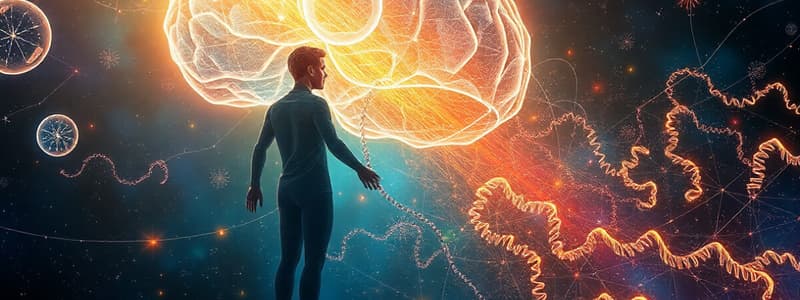Podcast
Questions and Answers
How do the structures of the ear contribute to hearing and balance?
How do the structures of the ear contribute to hearing and balance?
The outer ear collects sound waves, the middle ear amplifies them, and the inner ear converts sound into nerve impulses and helps maintain balance.
What roles do rods and cones play in the function of the eyes?
What roles do rods and cones play in the function of the eyes?
Rods are responsible for low-light sensitivity and do not perceive color, while cones are sensitive to color and function best in brighter light.
Explain how the olfactory receptors contribute to the sense of smell.
Explain how the olfactory receptors contribute to the sense of smell.
Olfactory receptors detect airborne chemicals in the nose, and signals from them are processed by the olfactory bulb to help identify odors.
What are the five primary tastes detected by the tongue?
What are the five primary tastes detected by the tongue?
Describe the role of skin receptors in the perception of touch and temperature.
Describe the role of skin receptors in the perception of touch and temperature.
What is the role of proprioceptors in the body?
What is the role of proprioceptors in the body?
How do sense organs adapt to constant stimuli?
How do sense organs adapt to constant stimuli?
What are some common disorders associated with sense organs?
What are some common disorders associated with sense organs?
Flashcards are hidden until you start studying
Study Notes
Sense Organs
Overview
- Sense organs are specialized structures that detect stimuli and enable the senses.
- They play a crucial role in perception and interaction with the environment.
Major Sense Organs
-
Eyes (Vision)
- Detect light and allow for the perception of images and colors.
- Composed of structures like the cornea, lens, retina, and optic nerve.
- Types of photoreceptors:
- Rods: Low-light sensitivity, no color perception.
- Cones: Color sensitivity, function in brighter light.
-
Ears (Hearing and Balance)
- Detect sound waves and maintain balance.
- Composed of:
- Outer Ear: Collects sound waves.
- Middle Ear: Amplifies sound (ossicles: malleus, incus, stapes).
- Inner Ear: Converts sound into nerve impulses (cochlea) and vestibular system for balance.
-
Nose (Smell)
- Detects airborne chemicals (odorants) and contributes to taste.
- Contains olfactory receptors in the olfactory epithelium.
- Involves the olfactory bulb in processing offactory signals.
-
Tongue (Taste)
- Detects dissolved substances through taste buds.
- Five primary tastes:
- Sweet
- Sour
- Salty
- Bitter
- Umami (savory)
-
Skin (Touch and Temperature)
- Contains receptors for pressure, pain, temperature, and vibration.
- Layers of skin, including dermis and epidermis, house these receptors.
- Involved in protective and sensory functions.
Additional Sensory Systems
-
Vestibular System
- Located in the inner ear, responsible for balance and spatial orientation.
-
Proprioceptors
- Found in muscles and joints, these receptors provide information about body position and movement.
Functioning of Sense Organs
- Each sense organ transmits signals to the brain via sensory neurons.
- The brain processes these signals to interpret sensations.
Adaptation
- Sense organs can adapt to constant stimulus:
- Decrease in sensitivity (e.g., habituation to strong odors).
Disorders of Sense Organs
- Common disorders include:
- Myopia (nearsightedness), hyperopia (farsightedness) for vision.
- Tinnitus (ringing in ears), hearing loss for auditory function.
- Hyposmia or anosmia (reduced or lost sense of smell).
Importance
- Sense organs are vital for survival, interaction, and navigating the environment.
- They contribute to the overall quality of life by enabling experiences.
Sense Organs
- Specialized structures that detect stimuli and enable the senses
- Play a crucial role in perception and interaction with the environment
Major Sense Organs
- Eyes (Vision): Detect light and allow for perception of images and colors
- Structures: Cornea, lens, retina, optic nerve
- Photoreceptors:
- Rods: Sensitive to low light, no color perception
- Cones: Sensitive to color, function in brighter light
- Ears (Hearing and Balance): Detect sound waves and maintain balance
- Composed of:
- Outer ear: Collects sound waves
- Middle ear: Amplifies sound (ossicles: malleus, incus, stapes)
- Inner ear: Converts sound into nerve impulses (cochlea) and vestibular system for balance
- Composed of:
- Nose (Smell): Detects airborne chemicals (odorants) and contributes to taste
- Contains olfactory receptors in the olfactory epithelium
- Involves the olfactory bulb in processing olfactory signals
- Tongue (Taste): Detects dissolved substances through taste buds
- Five primary tastes:
- Sweet
- Sour
- Salty
- Bitter
- Umami (savory)
- Five primary tastes:
- Skin (Touch and Temperature): Contains receptors for pressure, pain, temperature, and vibration
- Layers of skin, including dermis and epidermis, house these receptors
- Involved in protective and sensory functions
Additional Sensory Systems
- Vestibular System: Located in the inner ear, responsible for balance and spatial orientation
- Proprioceptors: Found in muscles and joints, these receptors provide information about body position and movement
Functioning of Sense Organs
- Each sense organ transmits signals to the brain via sensory neurons
- The brain processes these signals to interpret sensations
Adaptation
- Sense organs can adapt to constant stimulus
- Decrease in sensitivity (e.g., habituation to strong odors)
Disorders of Sense Organs
- Common disorders include:
- Vision: Myopia (nearsightedness), hyperopia (farsightedness)
- Auditory: Tinnitus (ringing in ears), hearing loss
- Smell: Hyposmia or anosmia (reduced or lost sense of smell)
Importance
- Sense organs are vital for survival, interaction, and navigating the environment
- They contribute to the overall quality of life by enabling experiences
Studying That Suits You
Use AI to generate personalized quizzes and flashcards to suit your learning preferences.




